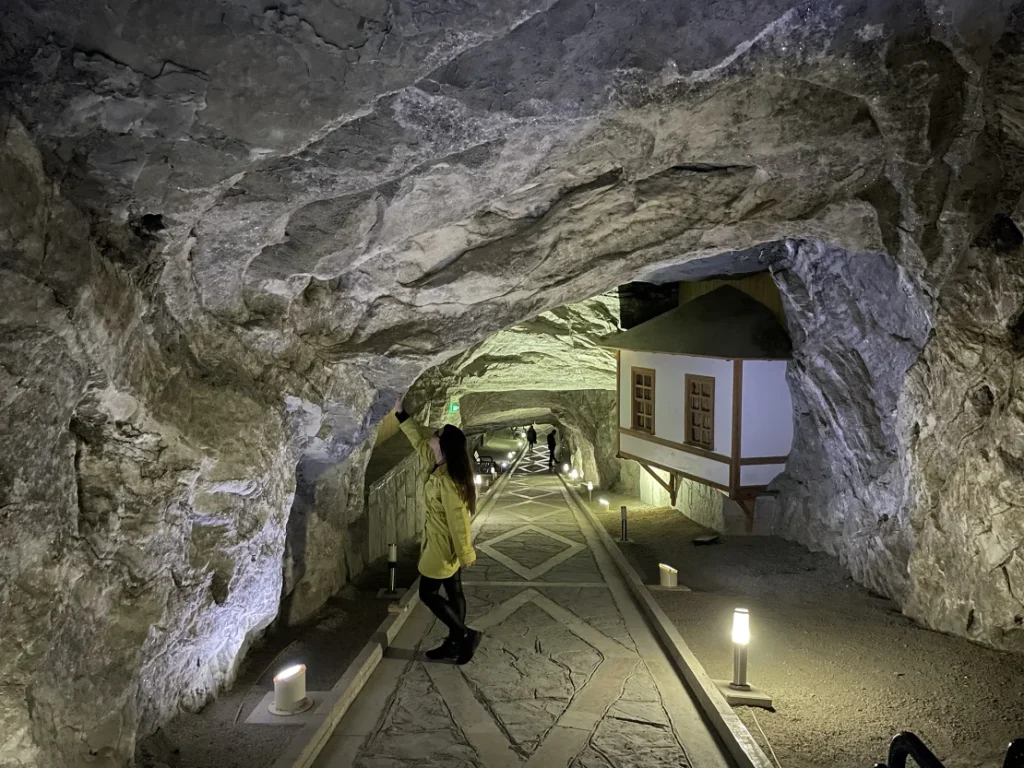There are several historical sites in Nakhchivan, a landlocked exclave located roughly 260 miles west of Baku, the capital of Azerbaijan. These include castles, towers, tombs, and even wish-making caverns. The main attraction, though, is Duzdag Salt Mine, sometimes known as “Salt Mountain,” which doubles as the area’s biggest medical tourism facility. Nestled 360 feet (110 meters) below the surface, this popular site provides supplementary and alternative medicine for respiratory ailments in chambers first excavated about 5,000 years ago.Situated at an elevation of 3,848 feet (1,173 meters), the caves are breathtakingly situated in the highlands, just a short seven-mile drive from Nakhchivan city. On the location of salt mines that archaeologists had uncovered in the 1970s, the contemporary Physiotherapy Center was established in 1979. It is thought that salt was extracted from this area and sent to the Middle East as early as the third millennium BCE. There are conflicting origin myths regarding how the caves came to be known for their healing abilities, thus it’s unclear just how that happened. There is a legend that the Duzdag salt is sacred to the people, who have long admired the caves for their healing properties. According to legend, archaeologists who excavated during the 20th century reported feeling better from their asthma and bronchitis.
Salt therapy:
Salt-based cures are nothing new. In mid-19th century Poland Feliks Boczkowski, a physician at a salt mine, observed that miners rarely suffered from respiratory diseases and appeared to have notably healthy constitutions.
Boczkowski is considered the founder of what would later be known as halotherapy: breathing in air with tiny salt particles with the aim of improving breathing.
Halotherapy has risen in popularity in recent years, although the scientific community isn’t unanimously convinced of its benefits. Experts have noted that airborne salt can help thin mucus in breathing passages and draw in moisture. Salty environments are also typically allergen-free.
However, with no evidence-based findings to support the creation of medical guidelines, the American Lung Association’s advice is to always consult with your doctor before undertaking halotherapy or salt therapy.
When salt therapy is conducted below the Earth’s surface using the climate conditions and salt air found in naturally occurring caves, it’s known as speleotherapy. Such salt caves exist all over the world – in Ukraine, Hungary, Poland, Turkey, Germany and Switzerland – and are widely used by asthma patients as an alternative treatment.

What sets the Duzdag complex apart is its horizontal location, which allows patients to gradually adapt to the conditions in the cave as they walk towards their rooms, nearly 900 feet (or 300 meters) from the main entrance.
The serpentine road into the mine first reaches the neat one-story wooden building of the Physiotherapy Center, which stands in contrast to the mysterious sparkling walls inside the tunnel.
What is noticeable immediately, even before entering the caves, is a very distinct smell of Duzdag salt, markedly different from the light salty breeze carried from the nearby Caspian Sea.
The glistening salt layers of the walls are 8.2 meters thick (nearly 27 feet). The spacious tunnel with benches on the sides and even a rest area with TV and tables, doesn’t feel claustrophobic.
Closer inspection of small pinkish rocks near the walls, reveal that even these are made of salt. People collect bigger pieces and keep them at home in the belief that crystals remove negativity.
It takes time to get used to the very potent smell of salt, but it’s not hard to breathe in the tunnel. The center says that natural ventilation in the cave prevents the accumulation of harmful gases such as carbon dioxide, methane, and nitrogen.
It claims that the favorable combination of the location above the sea level, the temperature, humidity, atmospheric pressure, ionic composition of oxygen in the mines, and bacteriological composition has been instrumental in the successful treatment of such diseases as bronchial asthma, chronic bronchitis, pollinosis and allergic rhinitis.







